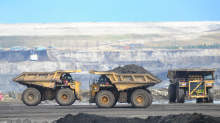Oil sands fuels think-tank debate over Dutch disease
 Is the boom a boon or a bane?
Is the boom a boon or a bane?Spurred in part by New Democratic Party Leader Thomas Mulcair’s political rhetoric, Canadians are debating the benefits of the oil sands boom, and whether its impact is a blessing or curse for the rest of the country.
Dueling reports issued Wednesday looked at the same data and came to dramatically different conclusions about whether Canada is now suffering from a version of the dreaded Dutch disease.
In a largely negative assessment, the Calgary-based environmental group Pembina Institute warns of “oil sands fever, a strain that is creating clean winners and losers in the Canadian economy and could pose significant risk to Canada’s competitiveness in the emerging clean energy economy.”
In contrast, Ottawa’s Macdonald-Laurier Institute, a conservative think tank, dismisses the fears that Canada’s booming resource sector is hurting central Canadian manufacturers by driving up the loonie to uncompetitive heights.
While the high commodity prices may well result in more petroleum exports and fewer sales of manufactured goods outside the country, the Macdonald-Laurier economists argue the oil and gas industry uses its higher revenues to purchase goods and services in the rest of the country.
“In effect petroleum-rich provinces become the new ‘export markets’ for the rest of the country,” they argue. “Canadians in general, including in the manufacturing sector, are enriched by the presence of bountiful resource deposits.”
At the same time, the boom resource economy in western Canada – and to a lesser extent, Newfoundland and Labrador - is pouring tax dollars into federal coffers, allowing Ottawa to finance service or reduce taxes for all Canadians.
The reports come as Mr. Mulcair heads to Alberta this week to amplify his recent call for a more measured and sustainable pace for resource development, while federal Conservatives condemn the New Democrats as being anti-growth.
The two reports released Wednesday look to the same study by the Canadian Energy Research Institute (CERI) to buttress their arguments. The CERI study, released last May, models the economic impacts of oil sands expansion from 2010 to 2035 and, in its “realistic scenario,” projects productions will grow from 1.6 million barrels per day today, to 2.7-million barrels in 2016 and a stunning 5.4 million barrels per day in by 2035.
Already, the industry has permits to raise production to 5.1 million barrels daily, though companies still need to make final investment decisions for most of that proposed expansion.
Citing the CERI report, Pembina analyst Nathan Lemphers acknowledges important economic benefits of oil sands production - which now accounts for 4 per cent of Canadian GDP, has led the country in growth among industrial sectors and supports 339,00 jobs, directly and indirectly.
But Mr. Lemphers noted that the benefits are largely concentrated in Alberta.
CERI estimated that the province will receive 94 per cent of the $4.9-trillion in economic activity generated by the oil sands between 2010 and 2035. Ontario will see only 3 per cent of those benefits, and Quebec, just 0.7 per cent.
Echoing concerns raised by former Bank of Canada governor David Dodge, Pembina warns that unbridled growth in the oil sands will not only compromise Ottawa’s ability to meet greenhouse gas emissions targets, but will exacerbate regional tensions that already plague the country.
But Macdonald-Laurier Institute cites several studies - including the May 2011 one from CERI - to suggest that the rest of Canada benefits from not only the oil sands, but construction of pipelines and other oil and gas industry investment.
Another CERI report suggests that, overall, the oil and gas industry will contribute $116-billion to the Ontario economy over the next 25 years. While sounds like a big number, it represents only $4-billion a year to $600-billion provincial economy. And it does not take into account the negative impacts that a oil-fueled loonie has on the province’s manufacturing sector.
But those studies only account for the direct impacts. They don’t factor in the opportunities created for mobile Canadians who have the ability to relocate to find work, or the tax revenues that flow into federal coffers to support national programs. CERI has estimated Ottawa will receive an average of $16.3-billion a year for the next 25 years from oil sands-related tax revenues.
The view that “oil and gas development is creating winners in a few provinces at the expense of numerous losers in other regions is not borne out in the evidence,” Macdonald-Laurier president Brian Lee Crowley said.
“On the contrary, that evidence suggests that benefits are both substantial and surprisingly broadly distributed nationally.”
You can return to the main Market News page, or press the Back button on your browser.

